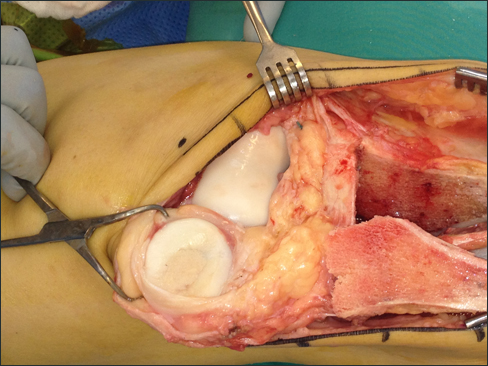Cartilage resurfacing, anteromedialization, or both for patella cartilage lesions?
It can be difficult to determine the best surgical option when dealing with symptomatic focal patella cartilage lesions. Distal realignment (anteromedialization) can be used to unload patella cartilage lesions with or without cartilage resurfacing. Anteromedialization has been shown to decrease distal and lateral patellofemoral contact pressure. The key to surgical planning is to know the location of the lesion and the tibial tubercle–trochlear groove (TT-TG) distance.



Figure 1. A 21-year-old female with a symptomatic patella cartilage lesion is shown. The TT-TG distance measured 21 mm preoperatively without evidence of patella alta. An anteromedial tibial tubercle transfer was performed to unload the symptomatic cartilage lesion in addition to cartilage resurfacing. Preoperative T2-weighted MRI reveals a large patella cartilage lesion (A). Intraoperative image confirms central patellar defect (B). Shown is an everted image of the patella lesion after cell-based cartilage resurfacing and prior to definitive fixation of the tubercle (C).
Source: Bollier M.
We recommend an isolated anteromedialization tubercle osteotomy for lateral patella lesions. If the TT-TG is greater than 15 mm, then a standard anteromedialization is performed. If the TT-TG is less than 15 mm, the osteotomy should be made steeper to shift the tubercle more anterior than medial. For central and medial patella lesions, we recommend both cartilage resurfacing and an unloading anteromedialization tubercle osteotomy.

Matthew Bollier
The addition of the tibial tubercle osteotomy can also make patella cartilage resurfacing procedures less technically demanding. The osteotomy allows easier eversion of the patella and visualization of the cartilaginous defect (Figure 1A-C). We recommend a cell-based cartilage resurfacing technique when dealing with patella lesions. It is very difficult to reproduce the patella surface anatomy with an OATS procedure. When the TT-TG is corrected to less than 12 mm and there is no residual instability, cell-based resurfacing procedures have shown to favorable results.
References:
Beck PR. Am J Sports Med. 2005;33(11):1710-1715.
Peterson L. Am J Sports Med. 2002;30(1):2-12.
Matthew Bollier, MD, is from the Department of Orthopaedic Surgery, University of Iowa Sports Medicine Center.
Disclosure: Bollier has no relevant financial disclosures.
